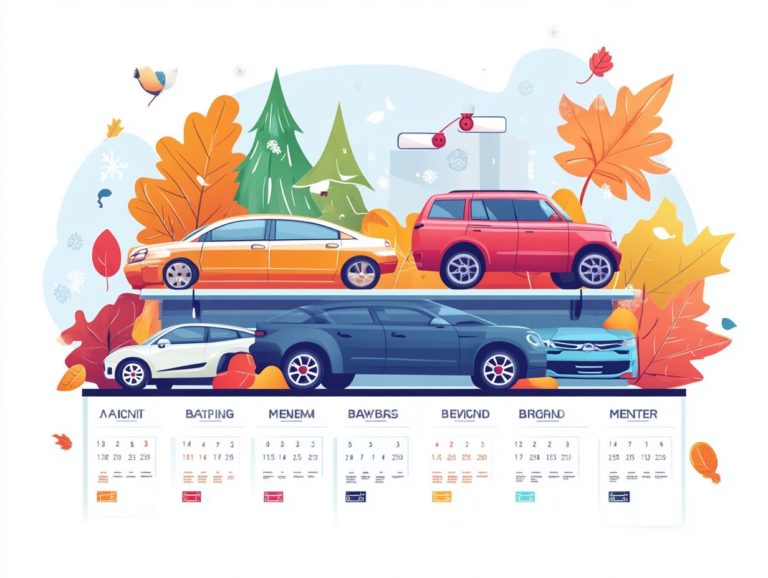How to Avoid Buyer’s Remorse After Purchase
Buyer s remorse is a prevalent experience that many individuals encounter following a substantial purchase.
This article delves into the essence of buyer’s remorse, examining its roots and the signs you should be aware of. It also investigates effective pre-purchase strategies and post-purchase techniques designed to help you sidestep that unwelcome sensation of regret.
Additionally, this article offers coping mechanisms to manage buyer’s remorse when it arises, equipping you to make confident and well-informed decisions moving forward.
Contents
- Key Takeaways:
- Understanding Buyer’s Remorse
- Signs of Buyer’s Remorse
- Ways to Avoid Buyer’s Remorse
- Dealing with Buyer’s Remorse
- Frequently Asked Questions
- 1. How can I avoid buyer’s remorse after making a purchase?
- 2. What are some tips for preventing buyer’s remorse?
- 3. Is buyer’s remorse a common experience?
- 4. How can I avoid impulse purchases and potential buyer’s remorse?
- 5. Are there any warning signs that I may experience buyer’s remorse?
- 6. What should I do if I do experience buyer’s remorse after a purchase?
Key Takeaways:

- Take time to consider your purchase before making a decision! Avoid impulse buying to reduce the risk of buyer’s remorse.
- Post-purchase techniques such as keeping receipts, reviewing return policies, and seeking out positive reviews can help prevent buyer’s remorse!
- Dealing with buyer’s remorse can be challenging. Practicing effective coping methods, like talking to a friend or taking a break from the item, can help you overcome it!
Understanding Buyer’s Remorse
Understanding buyer’s remorse requires exploring the feelings and thoughts that follow impulsive purchases. Often, an emotional disconnect surfaces, leading to financial regret and a reconsideration of your buying choices amidst the act of buying things.
This phenomenon can manifest as anxiety surrounding the decision made. It reveals an underlying emotional turmoil that weakens customer loyalty and reshapes future buying behaviors.
Research from sources like Consumer Reports and the New York Times underscores the widespread nature of this issue. It emphasizes that well-crafted marketing strategies can significantly reduce its occurrence.
Definition and Causes
Buyer s remorse is that unsettling feeling of anxiety and emotional disconnect you experience after making a purchase, often accompanied by financial regret or reconsideration of your choice.
This feeling tends to surface when you realize that your decision may not align with your true values or needs. Factors contributing to this uncomfortable aftermath include impulsive purchases driven by excitement or the pressure of social norms.
For example, the urge to keep up with trends or societal expectations can lead you to buy things you don t actually need. This creates a breeding ground for doubt and second-guessing.
This emotional fallout not only clouds your satisfaction but may also influence your future buying habits. It nudges you toward a more cautious approach, striving to avoid the regret tied to unnecessary expenditures.
Signs of Buyer’s Remorse
Recognizing the signs of buyer’s remorse is essential for grasping the emotional journey that many consumers undergo after making a purchase. This often leads to a phase filled with doubt and regret, highlighting the complex feelings that can accompany their decisions.
Recognizing Common Indicators

Common indicators of buyer’s remorse may include heightened purchase anxiety, emotional disconnect from the product, and a frequent urge to return or exchange items due to dissatisfaction.
These signs often creep in as you start second-guessing your decision right after making the purchase or feel a nagging sense of regret about the financial commitment involved.
You might even experience physical reactions, such as restlessness or irritability, which arise from realizing that the item simply doesn t meet your expectations.
This emotional turmoil can intensify, especially when faced with return policies that feel complicated or unfriendly. The clarity of these policies plays a significant role in how you process feelings of regret, underscoring the deep connection between consumer psychology and retail experiences.
Ways to Avoid Buyer’s Remorse
Avoiding buyer’s remorse demands a level of strategic planning that encompasses both the moments leading up to a purchase and the reflections that follow.
Implementing effective pre-purchase strategies will enable you to make informed decisions, while post-purchase techniques can help bridge any emotional gaps, ensuring that your choices resonate positively long after the transaction is complete.
Next time you shop, remember these tips to avoid buyer’s remorse!
Pre-Purchase Strategies
Implementing effective pre-purchase strategies, like conducting thorough product research and developing a clear shopping plan, can significantly diminish the chances of experiencing buyer’s remorse. This approach enables you to make informed choices.
It’s essential for you to prioritize evaluating real products and quality, as these elements are crucial for ensuring your satisfaction. By examining reviews and verifying certifications, you can steer clear of counterfeit items that might fall short of your expectations.
Creating a budget and comparing similar products can elevate your decision-making process, reducing the anxiety that often comes with impulsive purchases. Such proactive measures not only lead to more rewarding purchases but also enhance your overall shopping experience, allowing you to feel confident in your selections.
This minimizes the likelihood of regret once the transaction is finalized.
Post-Purchase Techniques
Post-purchase techniques, such as understanding the refund process and familiarizing yourself with return policies, can significantly mitigate feelings of buyer’s remorse while enhancing your overall satisfaction as a customer.
Beyond these initial steps, taking a moment to reflect emotionally on your choices can be immensely beneficial. By looking into the reasons behind your purchases, you can reinforce positive feelings and validate your decisions.
Engaging in online discussions or reading reviews about your recent acquisition offers a sense of community, connecting you with others who share similar sentiments. This interaction fosters reassurance and can help alleviate any lingering doubts.
Creating a personal checklist of must-haves versus nice-to-haves before shopping can guide your future purchases, transforming them into more thoughtful and curated experiences.
Dealing with Buyer’s Remorse

Navigating buyer’s remorse requires you to utilize effective coping mechanisms that can help you bridge the emotional gap often created after a regrettable purchase. By doing so, you can rebuild trust in your purchasing decisions and regain confidence in your choices.
Effective Coping Mechanisms
Effective coping mechanisms for buyer’s remorse involve recognizing the emotional rollercoaster that comes with spending your hard-earned money and leveraging consumer protections to make savvy financial decisions.
This journey often entails acknowledging any feelings of regret or anxiety that might creep in after a purchase; after all, it’s a completely natural reaction. By employing strategies such as crafting a detailed budget, reflecting on previous purchases, and familiarizing yourself with return policies, you can gain clarity and confidence in your buying choices.
A wealth of resources is at your fingertips, from financial counseling services to online forums where you can connect with fellow consumers sharing their experiences. This community support can offer reassurance and practical advice, helping to alleviate emotional distress and reinforce responsible spending habits.
Final Thoughts and Recommendations
In concluding your exploration of buyer’s remorse, it’s crucial to offer thoughtful recommendations that address the emotional disconnect while cultivating customer loyalty through more effective purchasing strategies.
By understanding this common psychological challenge, you can take proactive steps, both as a consumer and as a brand. Start by thoroughly researching products before making a purchase; consider creating a list of essential features and potential alternatives to guide your decision-making process.
As a brand, prioritize transparent communication about your offerings, ensuring customers feel confident in their choices. Implementing easy return policies and providing post-purchase support can further reassure buyers, significantly reducing the likelihood of regret.
Embrace these strategies to beat buyer’s remorse and enjoy your shopping!
Frequently Asked Questions
1. How can I avoid buyer’s remorse after making a purchase?

To avoid buyer’s remorse, take your time. Research the product thoroughly before you buy.
2. What are some tips for preventing buyer’s remorse?
Set a budget and make a list of your needs and wants. Take a break before you buy; this gives you time to think it over.
3. Is buyer’s remorse a common experience?
Yes, many people feel buyer’s remorse. It’s especially common with big purchases or unplanned buys.
4. How can I avoid impulse purchases and potential buyer’s remorse?
Wait 24 hours before making a purchase. This pause helps you decide if you truly want the item.
5. Are there any warning signs that I may experience buyer’s remorse?
Warning signs include feeling pressured to buy or uncertain about the product. If you feel like you didn t get the best deal, take a step back.
6. What should I do if I do experience buyer’s remorse after a purchase?
If regret hits, remind yourself why you bought the item. If needed, return or exchange it. Learn from this experience for better decisions in the future.






